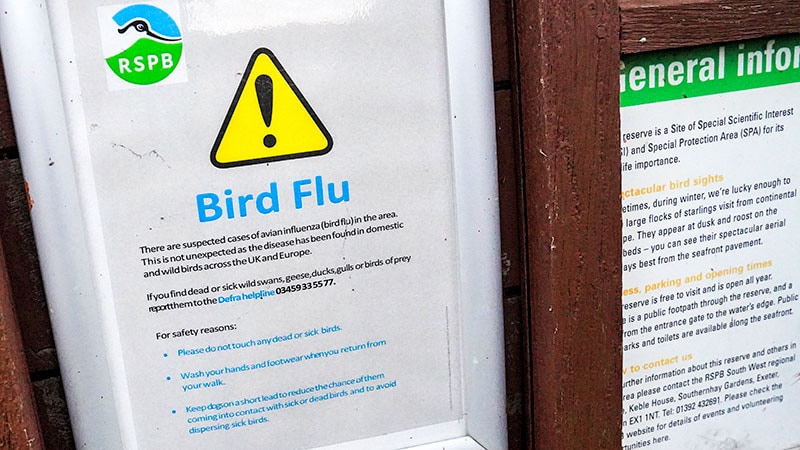European Scientists Warn of Potential Avian Flu Pandemic Threat
Core Concepts
Avian influenza viruses pose a significant pandemic risk, as they could potentially acquire the ability to spread efficiently among humans, leading to large-scale transmission due to lack of immunity.
Abstract
The content discusses the assessment by European scientists regarding the pandemic risk posed by avian influenza viruses. Key points:
- Avian influenza A(H5N1) viruses continue to spread among wild bird populations in the European Union (EU), and there is a threat of new strains carrying potential mutations for mammalian adaptation entering the EU and the wider European Economic Area (EEA).
- If the avian A(H5N1) influenza viruses acquire the ability to spread efficiently among humans, large-scale transmission could occur due to the lack of immune defenses against H5 viruses in humans.
- Despite many occurrences of human exposure to avian influenza since 2020, no symptomatic or productive infection in a human has been identified in the EU/EEA. The virus has not yet acquired the mutations required for airborne transmissibility between humans.
- However, it remains difficult to predict the evolutionary direction the virus will take in the future, and the "clock resets every minute" as the virus has the potential to spill over from birds to humans.
- The European report recommends a range of cautionary measures, including enhanced surveillance, access to rapid diagnostics, sharing of genetic sequence data, and a One Health approach to limit the exposure of mammals, including humans, to avian influenza viruses.
- The report also calls for consideration of preventative measures, such as vaccination of poultry flocks.
- Overall, the report is designed to move zoonotic infectious diseases higher up the agenda, as they should have been before the COVID-19 pandemic.
Customize Summary
Rewrite with AI
Generate Citations
Translate Source
To Another Language
Generate MindMap
from source content
Visit Source
www.medscape.com
European Scientists Assess Avian Flu Pandemic Risk
Stats
No symptomatic or productive infection in a human has been identified in the EU/EEA.
After almost three decades of human exposure to the A(H5N1) virus of the Gs/GD lineage, the virus has not yet acquired the mutations required for airborne transmissibility between humans.
Quotes
"If avian A(H5N1) influenza viruses acquire the ability to spread efficiently among humans, large-scale transmission could occur due to the lack of immune defenses against H5 viruses in humans."
"Clearly, humans are being exposed in the current USA cattle outbreak. But, arguably, what is more significant is how few cases there have been with this virus lineage and its close relatives, despite massive global exposures over the last 3 years. All diagnosed human cases seem to have been singletons, with no evidence of human-to-human transmission."
"The trouble is, the clock resets every minute. Every time the virus has come out of a bird and gone somewhere, the clock is reset. So you can never say that just because it hasn't happened since whenever, it's never going to happen."
Key Insights Distilled From
by Peter Russel... at www.medscape.com 04-05-2024
https://www.medscape.com/viewarticle/european-scientists-assess-avian-flu-pandemic-risk-2024a10006jh
Deeper Inquiries
What specific genetic or biological factors are scientists monitoring in the avian influenza viruses that could lead to increased transmissibility and pandemic potential?
Scientists are closely monitoring specific genetic factors in avian influenza viruses that could enhance their transmissibility and pandemic potential. One crucial factor is the potential mutations that could occur in the virus, leading to mammalian adaptation. These mutations could enable the virus to efficiently spread among humans, posing a significant risk of large-scale transmission. Additionally, the report highlights the threat of strains circulating outside Europe entering the European Union and the wider European Economic Area, further increasing the risk of a pandemic. The lack of immune defenses against H5 viruses in humans also contributes to the potential for widespread transmission if avian A(H5N1) influenza viruses acquire the ability to spread efficiently among humans.
How effective have past pandemic preparedness efforts been in addressing the threat of zoonotic diseases, and what lessons can be learned to improve future preparedness?
Past pandemic preparedness efforts have had varying degrees of effectiveness in addressing the threat of zoonotic diseases. While there have been instances of human exposure to avian influenza, no symptomatic or productive infections have been identified in the EU/EEA. This suggests that current measures have been somewhat successful in preventing widespread transmission. However, the unpredictability of virus evolution poses a significant challenge to preparedness efforts. Lessons that can be learned to enhance future preparedness include the importance of enhanced surveillance, rapid diagnostics, and sharing of genetic sequence data. Collaboration among authorities, adopting a One Health perspective, and implementing preventative measures such as vaccination of poultry flocks are crucial in mitigating the risks posed by zoonotic diseases.
Given the inherent unpredictability of virus evolution, what innovative approaches or technologies could be developed to enhance early detection and rapid response to emerging zoonotic threats?
To enhance early detection and rapid response to emerging zoonotic threats, innovative approaches and technologies can be developed. One key strategy is the advancement of genetic sequencing technologies to quickly identify mutations in viruses that could increase their transmissibility. Implementing real-time surveillance systems that monitor wildlife, domestic animals, and humans for potential outbreaks can help in early detection. Utilizing artificial intelligence and machine learning algorithms to analyze vast amounts of data for patterns indicative of zoonotic disease spread can also enhance early warning systems. Additionally, investing in research on broad-spectrum antiviral drugs and universal vaccines that can target a wide range of viruses can improve preparedness for future zoonotic threats.
0
